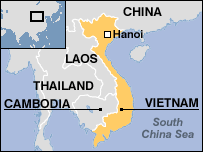









| Country name: Socialist Republic of Vietnam Population: 88.6 million Capital: Hanoi Land area: 329,247 sq km ( 127,123 sq miles) Mayjor language: Vietamese Mayjor religion: Buddhism Ethonic minorities: 54 minorities, Viet (King) people making the majority of 87% Life expectancy: 68 years ( men), 72 years (women) Monetary unit: 1 dong = 100 xu Main exports: Clothing, petroleum, footwear, rice, pepper, coffee, seafood GNI per capita: US$550 ( World Bank, 2005) Internet domain: .vn International dialling: +84   GEOGRAPHY
Vietnam shares its land borders with Cambodia and Laos to the west and China to the north. Cover an area of 312.000 km2 and eastern border is the 3,000 km coastline facing the East Sea. The country’s topography varies from coastal plains to mountains ranges. CLIMATE AND SEASONS Vietnam has a tropical monsoon climate with wet and dry seasons. These seasons vary from north to south and with elevation changes. In general, the dry season lasts from November to April in the north, south and central highland regions. The coolest, driest times to visit are from October to January (North), from February to April (Central Highlands) and from late December to March (South).
PEOPLE
Vietnam has a population of 83 million, 85% of which are ethnic Vietnamese. 15% of the population is ethnic-Chinese, Khmers, Chams or members of more than 60 ethnic-minority peoples who live in the mountainous regions of the central highlands or northern regions. The largest ethnic minority groups are the Tay, the White Thai, the Black Thai and the H’mong. These groups display similar rural and agricultural lifestyles, but have different languages, dress, cultures, and physical features. LANGUAGE Vietnamese is a tonal language that uses the Roman alphabet together with tone and diacritical marks. Much the language is Sino/Vietnamese, though influences from French and English are also apparent. Today, English has replaced French and Russian as the most studied and spoken foreign language, and is widely spoken in major cities RELIGION Buddhism is the most common religion in Vietnam, with about 60% of the population practicing some form of Buddhism. About 8% of the population is Catholic. Other religions practiced include Protestantism, Confucianism, Taoism, Islam, Hinduism and Caodaism. HOLYDAYS & FESTIVAL Tet, the Lunar New Year, is undoubtedly the most important holiday for the Vietnamese. It usually takes place in February and is celebrated for five days. Visitor should be aware that virtually all businesses are closed during this period and international and domestic flights are fully booked as overseas Vietnamese return to visit their families and friends. Other significant public holidays are on April 30th (Reunification Day), May 1st (International Labour Day) and September 2nd (National Day). Other popular holidays include New Year’ Day (January 1st), and May 19th (Ho Chi Minh’s birthday) HANDICRAFTS AND SOUVENIRS Vietnam is particularly known for its various styles of lacquer ware (mother of pearl inlay, duck shell etc.) and for its growing silk industry. A wide array of other handicrafts it also available, including quality hand embroidery, woodcarvings, brass or marble figurines and ivory or tortoiseshell accessories. Paintings, silk screens, and hand-painted ceramics can be found in Hanoi and Ho Chi Minh City. War paraphernalia, such as army helmets, are popular souvenirs, as are the old cameras, watches, stamps and coins sold on side streets in Ho Chi Minh City. FOOD Vietnam’s amazing cuisine boasts about 500 traditional specialties. Meals are generally not spicy and the use of a wide array of interesting sauces and ingredients make for a unique flavour. Thanks to the Buddhist monks, Vietnam’s vegetarian cooking has a long history and guests will not be disappointed by the great range of vegetable, tofu, rice and noodle dishes. Beyond the delights of the street stalls and Vietnamese restaurants, the major cities have an increasing selection of international restaurants. An abundant array of fresh tropical fruits is available year-round. VISA For most visitors to Vietnam, visa is advised to obtain at Vietnamese Embassy or Consulate overseas. Some Embassy & Consulate required the copy of visa approval which is processed by your Vietnam travel agent and some are not required processing in advance. Visa on arrival also available but the visa on arrival must be approved in advanced. Visitor is advisable to contact travel for visa help. Visa fee is 25 USD – 30 USD. AIRPORT TAX International airport tax is $14 from Noi Bai airport (Hanoi) and $12 from Tan Son Nhat airport (HCMC) and Danang airport. Domestic airport tax included in the airfare. BUSINESSES HOURS (LOCAL TIME IS GMT PLUS 7 HOURS) Most business offices are open from 08:00 till 12:00 and from 13:00 till 17:00, Monday through Friday. Banks generally operate from 08:00 till 15:00hrs. Most private companies work on Saturday, while government offices are closed HEALTH Vaccination is not required for entry into Vietnam, but we suggest you check with doctor as some countries recommend their citizens be inoculated before embarking on an oversea adventure. TELECOMMUNICATIONS There are three cellular phone service providers offering convenient communication via the GSM system, therefore many citizens now carry mobile phones. Phone IDD and facsimile are also available. Internet It is easy and very cheap to access the Internet and email in Vietnam. There are a plenty of Internet cafes and Internet services, many are of them open until late at night. Currently the charge is between 40 cents to 70 cents dollars per hour. ELECTRICITY 220 volt |
||||||||||||||||||||||||||||||||||||||||||||||||||||||||||||||||||||||||||||||||||||||||||||||||||||||||||||||||||||||||||||||||||||||||||||||||||||||||||||||||||||